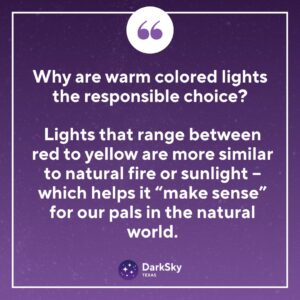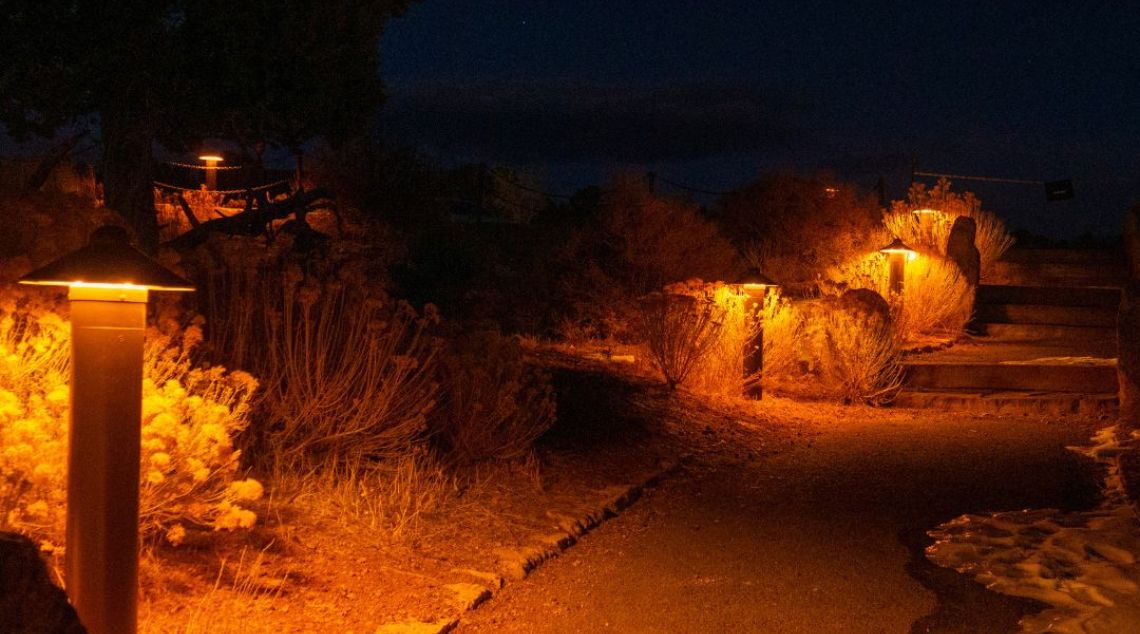The ability to lighten our nights has revolutionized our lives – our feeling of safety, productivity, and even our hobbies have all radically changed thanks to artificial lights. However, there’s a dark side to all these benefits: many outdoor lights can impact our health, encroach on our neighbor’s properties, interfere with wildlife, make it more challenging to see at night, and drown out the night sky.
But it doesn’t have to be this way. We can do a lot to prevent our outdoor lights from impacting the rest of the world. This is what our 5 Principles of Responsible Outdoor Lighting are all about: through intelligent, thoughtful design we can minimize the impact of our outdoor lights on the surrounding area while we improve visibility at the same time.
Today, we are looking at the fifth principle: using warm-colored lights. This is when all our other steps toward responsible outdoor lighting come together!

What Exactly are Warm-Colored Lights?
In the field of color theory, “color temperature” describes the hue of the light, as it appears to the human eye, rather than the actual temperature. It is measured in degrees Kelvin (K°) on a scale that ranges from 1,000K to 10,000K.
Lower color temperatures (1000K- 2700K) appear warm, with a yellow or orange tint. As the color temperature increases, the light appears cooler, shifting towards white and then blue tints at higher temperatures (5000K – 6500K).
You can liken this to an imaginary, pitch-black metal radiator. If we start heating it, it will glow red, orange, yellow, white, and bluish-white as it gets hotter.
Why Choose Warm Colored Lights?
Lights that range from red to yellow are more similar to natural fire or sunlight – which helps it “make sense” for our pals in the natural world.
This means:
- Easier on the eyes: If you’ve been driving at night and had a car coming the other direction with those white LED lights, or driven by a bright LED billboard at night, you know how harsh cooler lights can be on the eyes. Warm lights are softer on the eyes, create less glare, and make it easier to see at night.
- Less disruptive to wildlife: Many nocturnal animals are sensitive to light in the blue wavelength, which is more prevalent in cooler color temperatures. Warm lights are less likely to disrupt their natural behaviors and circadian rhythms.
- Reduced insect attraction: Insects are typically more attracted to cooler, bluer lights. Using warm lights can help reduce the “moth to a flame” effect, which can disrupt local insect populations and food chains.
- Minimal light pollution and glare: Warmer lights tend to scatter less in the atmosphere and in our eyes, reducing overall light pollution and glare. This benefits nocturnal species and can help preserve the natural darkness needed for many ecological processes.
- Plant health: Some plants are sensitive to light at night, and cooler lights can disrupt their natural cycles. Warm lights are less likely to interfere with plants’ circadian rhythms and seasonal changes.

How Do I Know If These Lights Are Right?
At the end of the day, “color temperature” is a bit of a metaphor – so we can’t exactly pull out a thermometer and measure our porch lights. Determining light temperature can be tricky, especially when using new bulbs such as LEDs.
Here’s how to check if your lights are the right color:
- Check the packaging: Many light bulbs nowadays are labeled “warm” or “cool”. If they’re not, they will list their color temperature in Kelvin. Aim for temperatures of 2000K – 2700K.
- Watch the color against a white wall: Warm lights appear yellowish or amber, while cool lights look white or bluish-white.
- Compare them to familiar sources: Warm lights resemble traditional incandescent bulbs or candlelight, while cool lights are more similar to midday sunlight.
- Use a color temperature meter: You can use a specialized device or smartphone app that measures color temperature for precise measurements.
Want to See More Night-Friendly Properties in Your Area?
In the fight against light pollution, there’s no better way to increase our impact than by combined action. This is why every landowner who implements the 5 Principles of Responsible Outdoor Lighting deserves public recognition and the chance to promote change around their neighbors.
This is why we are actively recruiting STARS around the state of Texas. Our Be A STAR program rewards landowners who commit to rethinking their use of outdoor lights. Learn more about it, apply, and spread the benefits of responsible outdoor lighting!


